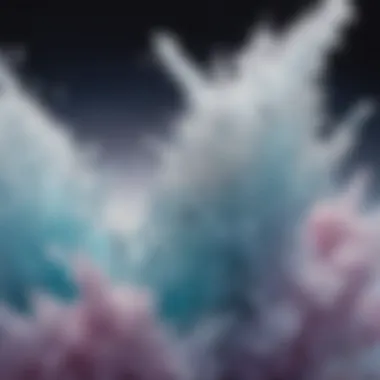Unveiling the Intricacies of Salt Crystallization Experiments


Science Fun Facts
Salt crystallization, while seemingly mundane, harbors a universe of wonders within its process. Through intricate molecular dance-offs, salt crystals emerge like tiny, geometric masterpieces. Some crystals can even take on distinct shapes, resembling intricate snowflakes on a microscopic scale, showcasing the mesmerizing beauty hiding within the salty solution.
Discover the Wonders of Science
In delving deeper into salt crystallization experiments, we unravel the harmony between factors such as temperature, concentration, and surface area that influence crystal formation. Witnessing the metamorphosis from dissolved particles to solid crystals sheds light on the elegant choreography choreographed by nature's laws, revealing how the seemingly simple can hold profound beauty and complexity.
Science Quiz Time
Engage your scientific curiosity with intriguing questions around salt crystallization experiments. Can you guess which environmental factor plays the most significant role in crystal size formation? Test your knowledge on the ideal conditions for growing large, well-formed salt crystals, inviting a journey of discovery and exploration into the microscopic world of crystal growth.
Science Experiment Showcase
Embark on a hands-on exploration of salt crystallization experiments with easy-to-follow steps. Begin by preparing a supersaturated salt solution and observe the mesmerizing process of crystallization unfold before your eyes. Remember to handle materials with care, following safety protocols to ensure a smooth and secure experimental experience.
Introduction to Salt Crystallization
Salt crystallization is a captivating scientific process that unveils the intricate formations within salt crystals. Understanding the nuances of this phenomenon is crucial in various fields, from chemistry to geology. By delving into the depths of salt crystallization, we unravel the mysteries behind crystal growth and its implications in diverse industries. This section sheds light on the definition of salt crystallization and its fundamental principles, setting the stage for a comprehensive exploration.
Definition of Salt Crystallization
What is Salt Crystallization?


Salt crystallization is the crystalline growth process that occurs when a salt solution evaporates, leaving behind solid salt crystals. These crystals possess unique geometric patterns and structures, influenced by factors like temperature and concentration. The significance of salt crystallization lies in its role as a natural phenomenon and its applicability in various scientific experiments. The intricate patterns and formations resulting from salt crystallization are key to understanding crystal growth mechanisms and studying crystallography.
Basic Principles of Salt Crystallization
Salt crystallization operates based on the principles of nucleation and crystal formation. Nucleation is the initial step where solute particles form clusters, leading to the creation of seed crystals. These seed crystals then grow as more solute particles attach to them, resulting in the formation of larger salt crystals. Understanding these basic principles is essential in conducting salt crystallization experiments and analyzing crystal growth patterns over time.
Importance of Salt Crystallization Experiments
Relevance in Scientific Research
Salt crystallization experiments are highly relevant in scientific research due to their applications in crystallography, material science, and geology. By studying salt crystallization, researchers can gain insights into crystal formation processes, molecular structures, and crystal lattice arrangements. This experimental approach provides valuable data for advancing scientific knowledge and exploring new avenues in material synthesis and crystal engineering.
Applications in Various Industries
The applications of salt crystallization extend beyond scientific research to various industries such as pharmaceuticals, food processing, and cosmetics. In the pharmaceutical sector, salt crystallization techniques are employed in drug formulation to enhance solubility and bioavailability. In food processing, salt crystallization is utilized for salt production and preservation. Similarly, the cosmetics industry utilizes salt crystallization for manufacturing exfoliating scrubs and bath salts. By understanding the applications of salt crystallization in different industries, we appreciate its versatility and significance in shaping modern industrial processes.
Understanding the Process
Salt crystallization experiment, a staple in scientific investigations, plays a pivotal role in unveiling the intricate processes of crystal formation This section is a cornerstone of the article, shedding light on the fundamental aspects contributing to our comprehension of this phenomenon. From elucidating the initiation of crystallization to exploring the factors that mold crystal growth, the 'Understanding the Process' segment serves as a guide into the depths of salt crystallization ## Initiation of Crystallization
Nucleation Process
Experience the allure of nucleation process through its distinctive role in kickstarting salt crystallization. This quintessential stage harnesses minute particles to spark crystal growth, painting a vivid picture of nature's precision in crystalline formation. Delve into the nuances of nucleation, from its strategic significance in scientific inquiry to its indispensable presence in experimental setups, unraveling the complexities that define this foundational process ### Formation of Seed Crystals In the realm of salt crystallization, the formulation of seed crystals stands as a critical juncture that governs the course of crystal development. Unveiling the mysteries behind seed crystal formation uncovers a world where tiny crystals act as nucleation sites, anchoring the growth of larger salt formations. Reflect on the significance of seed crystals, their pivotal role in steering crystal morphology, and their reverberating impact across diverse scientific explorations ## Factors Influencing Salt Crystallization


Temperature
Temperature emerges as a key architect in shaping the intricate tapestry of salt crystallization, orchestrating the speed and formation of crystals. Discover how minute temperature variations can dictate crystal size, structure, and growth patterns, offering a glimpse into the delicate dance between energy and matter within crystalline structures. Unveil the secrets of temperature's influence on salt crystallization, from its capacity to accelerate or decelerate crystal growth to its role in crystalline symmetry and stability ### Concentration of Salt Solution Within the landscape of salt crystallization experiments, the concentration of the salt solution emerges as a silent orchestrator, dictating the rate and scale of crystal formation. Unravel the delicate interplay between salt concentration and crystal growth, as variations in solution strength unveil a spectrum of crystal sizes, shapes, and complexities. Explore the nuances of salt concentration in crystallization experiments, from its potential to enhance crystal purity to its role in fine-tuning experimental outcomes ### Surface Area As an unsung hero in the realm of salt crystallization, surface area exerts a profound influence on crystal formation dynamics, mediating the interaction between salt molecules and the container environment. Embark on a journey through the intricate relationship between surface area and crystal growth, as expansive surfaces pave the way for elaborate crystalline structures, while confined spaces yield compact formations. Uncover the nuances of surface area in crystallization experiments, from its ability to impart distinct crystal patterns to its role in influencing crystal growth kinetics
Experimental Setup
In this section focusing on Experimental Setup, the meticulous arrangement of materials and procedures is crucial for the success of the salt crystallization experiment. The Experimental Setup plays a paramount role in ensuring the reliability and accuracy of the results obtained. Without a well-thought-out Experimental Setup, the experiment may yield inconclusive or unreliable outcomes, impeding the advancement of scientific understanding. It is imperative to consider specific elements such as the choice of materials, the setup methodology, and the controlled environment to guarantee the experiment's success. The Experimental Setup sets the foundation for the experiment, guiding researchers through each step with precision and consistency.
Materials Required
Salt
Salt, a fundamental component of the salt crystallization experiment, plays a pivotal role in shaping the outcome of the crystallization process. The chemical composition and purity of the salt directly influence the formation and growth of crystals. Selecting the appropriate salt type is essential for achieving consistent and replicable results. The crystallization properties of salt, including its solubility and crystal structure, determine the characteristics of the crystals produced. Understanding the distinctive features of different salt varieties empowers researchers to optimize the experimental conditions for enhanced crystal formation and growth.
Water
Water serves as a critical solvent in the salt crystallization experiment, facilitating the dissolution of salt and crystal growth. The quality and purity of water utilized greatly impact the rate and quality of crystal formation. Controlling the water properties, such as temperature and purity, enhances the reproducibility of results and ensures experimental consistency. Proper hydration levels and water characteristics are vital considerations in maintaining the stability and integrity of the crystal growth environment.
Container
The choice of container for conducting the salt crystallization experiment is instrumental in creating a controlled and conducive environment for crystal formation. The container should be chemically inert to prevent interactions that may alter the crystallization process. Transparency of the container allows researchers to monitor crystal growth progress without disturbing the experiment. Size and shape of the container also influence factors such as evaporation rate and concentration gradients, impacting crystal size and morphology. Careful selection of an appropriate container is vital for maintaining experimental accuracy and reproducibility.
Procedures for Conducting Experiment


Step-by-Step Instructions
The Step-by-Step Instructions outline the chronological sequence of actions required to execute the salt crystallization experiment successfully. Clear and detailed instructions enhance reproducibility and minimize errors during experimentation. Each step in the procedure is meticulously designed to control variables and monitor the progress of crystal growth. Providing comprehensive guidance from initial setup to final observation, the Step-by-Step Instructions offer a structured approach to conduct the experiment systematically. Detailed explanations and achievable milestones within the instructions guide researchers through the experimental process with precision and clarity.
Observations and Analysis
Observations and Analysis play a pivotal role in comprehending the intricacies of salt crystallization. By carefully observing crystal growth patterns, researchers can decipher fundamental mechanisms underlying this phenomenon. The meticulous analysis of how crystals evolve over time provides invaluable insights into the physical and chemical processes at play. Through systematic observation, scientists can ascertain the size and shape of crystals, shedding light on the intricate details of their formation. Furthermore, analyzing crystal growth patterns allows for the interpretation of results with accuracy, leading to concrete conclusions regarding the experiments conducted.
Crystal Growth Patterns
Crystal Formation Over Time: Examining the process of crystal formation over time provides a dynamic perspective on salt crystallization experiments. This aspect delves into the kinetics of crystal growth and the evolution of crystal structures throughout the experimental duration. By capturing the changes in crystals over time, researchers can unveil the underlying mechanisms governing crystal development. Highlighting crystal formation over time is essential in elucidating the temporal aspects of salt crystallization phenomena. This choice aligns well with the article's objectives as it offers a comprehensive view of how crystals progress from initiation to maturation. The unique feature of studying crystal formation over time lies in its capacity to capture transient variations and understand crystal growth dynamics, enriching the analysis of salt crystallization experiments.
Interpretation of Results
Implications of Findings: Interpreting the results obtained from salt crystallization experiments holds significant ramifications for scientific endeavors. The implications of findings encapsulate the broader implications of research outcomes, linking experimental data to theoretical frameworks. By dissecting the implications of findings, researchers can extrapolate conclusions and propose hypotheses for further exploration. The crucial characteristic of interpreting findings lies in its ability to bridge empirical data with scientific theories, fostering a deeper understanding of salt crystallization mechanisms. This aspect finds relevance in the article as it underscores the practical implications of experimental results, contributing to the advancement of scientific knowledge. The unique feature of interpreting findings lies in its capacity to uncover latent correlations and unveil hidden facets of salt crystallization dynamics, enriching the analysis presented.
Comparative Analysis: Conducting a comparative analysis offers a lens through which researchers can contrast different facets of salt crystallization phenomena. Comparative analysis serves as a methodological approach for juxtaposing multiple experimental outcomes and drawing parallels between distinct research findings. Through comparing various aspects of salt crystallization experiments, researchers can discern trends, variations, and anomalies across different studies. The salient characteristic of comparative analysis lies in its capacity to elucidate similarities and differences in experimental results, paving the way for deeper insights into salt crystallization processes. This choice stands out in the article due to its ability to provide a comprehensive view of salt crystallization research, fostering a nuanced understanding of the field. The unique feature of comparative analysis lies in its potential to uncover patterns, inconsistencies, and subtleties in experimental data, enhancing the analytical depth of salt crystallization investigations.
Conclusion
Understanding the significance of salt crystallization is paramount in grasping the intricate process behind crystal formation. This pivotal conclusion draws together the fundamental principles explored throughout the article, shedding light on the profound impact of conducting such experiments. By delving into the conclusion section, readers will gain a comprehensive understanding of why salt crystallization is not just a scientific experiment but a gateway to unlocking the mysteries of crystal growth and formation.
Key Takeaways
Significance of Salt Crystallization
Unveiling the importance of salt crystallization, it becomes evident that this aspect serves as the cornerstone of experimental studies on crystal formation. The significance of salt crystallization lies in its ability to mimic natural crystallization processes, providing researchers with invaluable insights into crystal growth mechanisms. A key characteristic of salt crystallization is its reproducibility and scalability, making it a favored choice for experimental investigations in various scientific fields. Researchers benefit greatly from the controlled environment salt crystallization experiments offer, allowing for precise observation and analysis of crystal formation. Despite its advantages, limitations exist concerning the complexity of replicating natural crystal growth patterns in laboratory settings.
Impact on Scientific Understanding
The impact of salt crystallization on scientific understanding is profound, enriching knowledge in the realms of chemistry, geology, and materials science. By exploring the impact on scientific understanding, researchers can uncover the intricate details of nucleation processes and crystal growth kinetics. A key characteristic of this impact is its role in elucidating the mechanisms governing crystal formation, providing crucial data for theoretical models and practical applications. Salt crystallization's unique feature lies in its ability to act as a model system for studying crystal growth under controlled conditions. This methodological approach offers clear advantages in understanding the complexities of crystal nucleation and growth, enhancing scientific comprehension. However, challenges may arise when extrapolating findings from salt crystallization experiments to real-world scenarios, necessitating careful consideration and rigorous validation.







